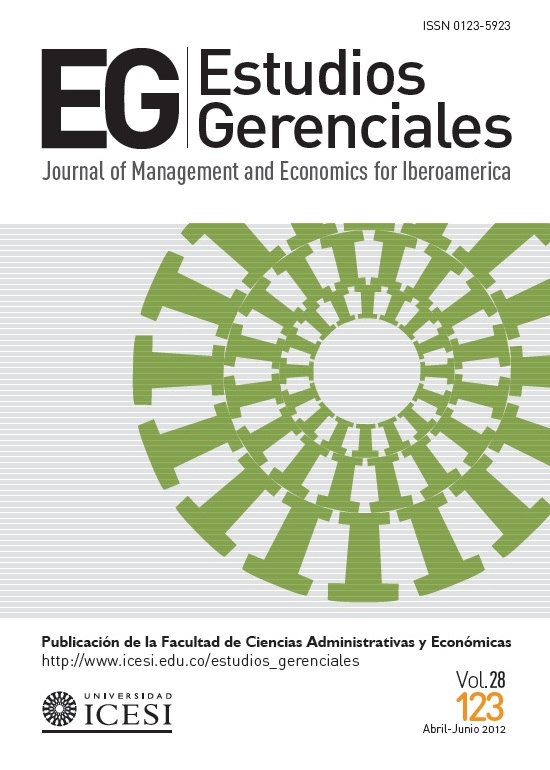ANÁLISIS DE LA POLÍTICA DE PAGO DE DIVIDENDOS EN EMPRESAS CHILENAS
DOI:
https://doi.org/10.1016/S0123-5923(12)70203-6Palabras clave:
Dividendos, propiedad, crecimiento, inversionistas institucionalesResumen
Este artículo analiza la tasa de pago de dividendos de las empresas chilenas, considerando aspectos como el pago de dividendos obligatorios, la fuerte concentra de la propiedad, las oportunidades de crecimiento y la presencia de inversionistas institucionales. La investigación se realizó para el período 2001 y 2007, a través de regresiones lineales múltiples, con selección de variables mediante el criterio de stepwise y estimación de parámetros a través de máxima verosimilitud, en donde se encontró evidencia de la utilización de la tasa de pago de dividendos para entregar información sobre los proyectos futuros de la empresa y el tratamiento justo de los accionistas. También se destaca el control ejercido por los inversionistas institucionales.
Descargas
Referencias
Agrawal, A. & Mandelker, G. (1987). Managerial incentives and corporate investment and financing decisions. The Journal of Finance, 42(4), 823-837.
Almazan, A., Hartzelly, J. & Starks, L. (2005). Active institutional shareholders and costs of monitoring. Evidence from executive compensation. Financial Management, 34(4) 5-35.
Azua, D., Pizaro, V., Silva, B. & Diaz, P. (2010). Influencia de la deuda con el público y la concentración de la propiedad en la transparencia del mercado de capitales chileno. Estudios Gerenciales, 26(115), 79-92. Recuperado de http://www.icesi.edu.co/revistas/index.php/estudios_gerenciales/article/view/360
Bena, J. & Hanousek, J. (2006). Rent extraction by large shareholders evidence using dividend policy in the Czech Republic. The Center for Economic Research and Graduate Education - Economic Institute Working Paper Series, 291, 1-50. Recuperado de http://www.cerge-ei.cz/pdf/wp/Wp291.pdf
Bennedsen, M. & Wolfenzon, D. (2000). The balance of power in closely held corporations. Journal of Financial Economics, 58(1-2), 113-139.
Chi-Wen, J. & Xing, X. (2005). Tunnelling dividends. Tulane University -A.B. Freeman School of Business and Tsinghua University Working Paper Series. Recuperado de http://www.accountancy.smu.edu.sg/research/seminar/pdf/JevonsLEE_paper.pdf
Chien-Ting, L. (2002). Dividend policies, legal regimes and institutional structures in the Asia Pacific region. Asia Pacific Journal of Economic and Business, 6(2), 4-16.
D´'Mello, R., Mukherjee, T. & Tawanatuchai, O. (2001). Forces versus voluntary dividends reaction: an agency cost explanation. The Financial Review, 36(1), 1-22.
Easterbrook, F. (1984). Two agency cost explanations of dividends. The American Economic Review, 74(4), 650-659.
Fuenzalida, D., Nash, M. & Mongrut, S. (2008). Stocks splits la bolsa de valores de Lima Afectan el rendimiento y la liquidez de los títulos? Estudios Gerenciales, 24(109), 11-36. Recuperado de http://www.icesi.edu.co/revistas/index.php/estudios_gerenciales/article/view/274
Gugler, K. (2003). Corporate governance, dividend payout policy, and the interrelation between dividends, R&D, and capital investment. Journal of Banking & Finance, 27(7), 1297-1321.
Holder, M., Langrehr, F. & Hexter, J. (1998). Dividend policy determinants: An investigation of the influences of stakeholder theory. Financial Management, 7(3), 73-82.
Jensen, M. (1986). Agency costs of free cash flow, corporate finance, and takeovers. The American Economic Review, 76(2), 323-329.
Jensen, M. & Meckling, W. (1976). Theory of the firm: managerial behaviour, agency costs and ownership structure. Journal of Financial Economics, 3(4), 305-360.
Khang, K. & King, D. (2002). Is dividend policy related to Information Asymmetry? Evidence from Insider Trading Gains. AFA 2003 Washington, DC Meetings (working paper) Recuperado de http://papers.ssrn.com/sol3/papers.cfm?abstract_id=342621
La Porta, R., López-de Silanes, F., Shleifer, A. & Vishny, R. (1999). Corporate ownership around the world. Journal of finance, 54(2), 471-517.
La Porta, R., López-de Silanes, F., Shleifer, A. & Vishny, R. (2000). Agency problem and dividend policies around the world. The Journal of Finance, 55(1), 1-33.
Lefort, F. (2003). Gobierno corporativo ¿Qué es? Y ¿Cómo andamos por casa? Cuadernos de Economía, 40(120), 207- 237.
Lefort, F. & Walker, E. (2000). Ownership and Capital Structure of Chilean Conglomerates. Facts and Hypotheses of Governance. Abante, 3(1), 3-27.
Lefort, F. & Walker, E. (2005). The effect of corporate governance practices on company market valuation and payout policy in Chile. Latin American Research Network (working paper No. 515). Recuperado de http://papers.ssrn.com/sol3/papers.cfm?abstract_id=676710
Lippert, R., Nixon, T. & Pillote, E. (2000). Incentives compensations and stock price response to dividends increase announcement. The Financial Review, 35(4), 69-94.
Manos, R. (2002). Dividend Policy and Agency Theory: Evidence on Indian Firms. Manchester, UK: Institute for Development Policy and Management, University of Manchester. Recuperado de http://scholar.googleusercontent.com/scholar?q=cache:UWOMZyWL7AIJ:scholar.google.com/++Manos+R+(2002)+dividend&hl=es&as_sdt=0,5
Maquieira, C. & Danús, M. (1998). Costos de agencia y costos de transacción, como determinantes de la tasa de pago de dividendos. Estudios de Administración, 5(2), 49-77.
Maquieira, C. & Moncayo, I. (2004). Costos de agencia y Costos de transacción, como determinantes de la tasa de pago de dividendos: una extensión. Estudios de Administración, 11(2), 1-33.
Maury, C. & Pajuste, A. (2002). Controlling shareholders, agency problems, and dividend policy in Finland. The Finnish journal of Business Economics, 51(1), 15-45.
Mehran, H. (1992). Executive incentive plans, corporate control, and capital structure. The Journal of Financial and Quantitative Analysis, 27(4), 539-560.
Merlo, M., Vélez-Pareja, I., Londoño, D. & Sarmiento, J. (2009). Potentials dividends and actual cash flows. A regional Latin American Analysis. Estudios Gerenciales, 25(13), 151-184. Recuperado de http://www.icesi.edu.co/revistas/index.php/estudios_gerenciales/article/view/324
Miller, M. & Rock, K. (1985). Dividend policy under asymmetric information. The Journal of Finance, 40(4), 1031-1051.
Moh'd, M., Perrey, L. & Rimbey, J. (1995). An investigation of the dynamic relationship between agency theory and dividend policy. The Financial Review, 30(2), 367-385.
Myers, S. (2000). Outside equity. The Journal of Finance, 55(3), 1005-1037.
Nash, M. & Fuenzalida, D. (2004). The effect of dividend distribution on share return in Chile. Estudios Gerenciales, 93, 99-113. Recuperado de http://www.icesi.edu.co/revistas/index.php/estudios_gerenciales/article/view/148
Rozeff, M. (1982). Growth, Beta and Agency Costs as Determinants of Dividend Payout Ratios. Journal of Financial Research, 5(3), 249-259.
Publicado
Número
Sección
Licencia
Los autores de artículos serán responsables de los mismos, y por tal no comprometen los principios o políticas de la Universidad Icesi ni las del Comité Editorial de la revista Estudios Gerenciales. Los autores autorizan y aceptan la cesión de todos los derechos a la revista Estudios Gerenciales, tanto en su publicación impresa como electrónica. Luego de publicado el artículo, puede ser reproducido sin autorización, mencionando autor(es), título, año, volumen, número y rango de páginas de la publicación, y como fuente: Estudios Gerenciales (abstenerse de usar Revista Estudios Gerenciales).








